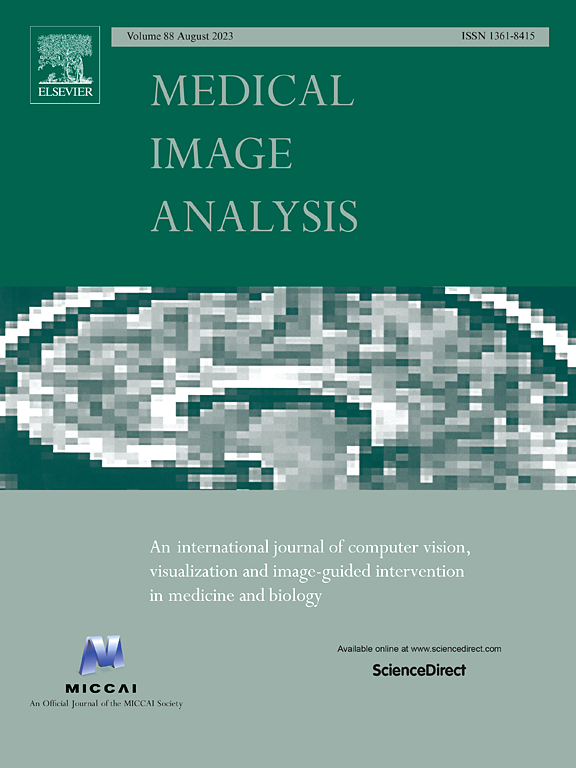Enhancing source-free domain adaptation in Medical Image Segmentation via regulated model self-training
IF 10.7
1区 医学
Q1 COMPUTER SCIENCE, ARTIFICIAL INTELLIGENCE
引用次数: 0
Abstract
Source-free domain adaptation (SFDA) has drawn increasing attention lately in the medical field. It aims to adapt a model well trained on source domain to target domains without accessing source domain data nor requiring target domain labels, to enable privacy-protecting and annotation-efficient domain adaptation. Most SFDA approaches initialize the target model with source model weights, and guide model self-training with the pseudo-labels generated from the source model. However, when source and target domains have huge discrepancies (e.g., different modalities), the obtained pseudo-labels would be of poor quality. Different from prior works that overcome it by refining pseudo-labels to better quality, in this work, we try to explore it from the perspective of knowledge transfer. We recycle the beneficial domain-invariant prior knowledge in the source model, and refresh its domain-specific knowledge from source-specific to target-specific, to help the model satisfyingly tackle target domains even when facing severe domain shifts. To achieve it, we proposed a regulated model self-training framework. For high-transferable domain-invariant parameters, we constrain their update magnitude from large changes, to secure the domain-shared priors from going stray and let it continuously facilitate target domain adaptation. For the low-transferable domain-specific parameters, we actively update them to let the domain-specific embedding become target-specific. Regulating them together, the model would develop better capability for target data even under severe domain shifts. Importantly, the proposed approach could seamlessly collaborate with existing pseudo-label refinement approaches to bring more performance gains. We have extensively validated our framework under significant domain shifts in 3D cross-modality cardiac segmentation, and under minor domain shifts in 2D cross-vendor fundus segmentation, respectively. Our approach consistently outperformed the competing methods and achieved superior performance.

通过调节模型自训练增强医学图像分割中的无源域自适应
近年来,无源域自适应技术在医学领域受到越来越多的关注。它的目标是在不访问源领域数据或不需要目标领域标签的情况下,将在源领域上受过良好训练的模型适应目标领域,以实现隐私保护和注释高效的领域适应。大多数SFDA方法使用源模型权值初始化目标模型,并使用源模型生成的伪标签指导模型自训练。然而,当源域和目标域存在巨大差异(例如,不同的模态)时,获得的伪标签质量会很差。与以往的作品通过对伪标签的提炼来提高质量来克服它不同,在这项工作中,我们试图从知识转移的角度来探索它。我们回收源模型中有益的领域不变先验知识,并将其领域特定知识从源特定更新到目标特定,以帮助模型在面临严重的领域转移时也能满意地处理目标领域。为了实现这一目标,我们提出了一个规范的模型自我训练框架。对于高可转移性的域不变参数,我们对其更新幅度进行约束,以保证域共享先验不会偏离目标域,并使其持续促进目标域自适应。对于低可转移性的特定于领域的参数,我们主动更新它们,使特定于领域的嵌入变成特定于目标的。将它们结合起来,即使在严重的域偏移情况下,该模型也能更好地处理目标数据。重要的是,所提出的方法可以与现有的伪标签细化方法无缝协作,从而带来更多的性能提升。我们分别在3D跨模态心脏分割的显著域偏移和2D跨供应商眼底分割的微小域偏移下对我们的框架进行了广泛的验证。我们的方法始终优于竞争对手的方法,并取得了卓越的业绩。
本文章由计算机程序翻译,如有差异,请以英文原文为准。
求助全文
约1分钟内获得全文
求助全文
来源期刊

Medical image analysis
工程技术-工程:生物医学
CiteScore
22.10
自引率
6.40%
发文量
309
审稿时长
6.6 months
期刊介绍:
Medical Image Analysis serves as a platform for sharing new research findings in the realm of medical and biological image analysis, with a focus on applications of computer vision, virtual reality, and robotics to biomedical imaging challenges. The journal prioritizes the publication of high-quality, original papers contributing to the fundamental science of processing, analyzing, and utilizing medical and biological images. It welcomes approaches utilizing biomedical image datasets across all spatial scales, from molecular/cellular imaging to tissue/organ imaging.
 求助内容:
求助内容: 应助结果提醒方式:
应助结果提醒方式:


